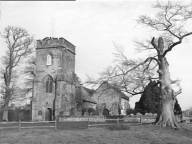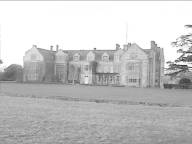![]()

![]()
26. St Peter's Parham

St Peter's Parham
This little country church is situated in Parham Park near Storrington only a few hundred yards from the famous Elizabethan house. Although the church has no Elizabethan glories it does have a charm all of its own.
The original village of Parham was pulled down in 1779 because of infection and the villagers rehoused at Rackham several miles away, so the church now stands in splendid isolation surrounded by grazing sheep.
The oldest part, the vestry, dates from 1400 but most of the present day church, including the tower, dates from rebuilding largely done between 1800-1820. All the plain glass windows date from 1815-25 as do the high boxed pews right down the nave. In the north transept is a large de luxe private boxed pew complete with a fireplace, something I have never seen in a church before. There is a story that the Squire would begin to shovel coal noisily onto the fire when he considered the Rector was preaching an overlong sermon. Over the fireplace hangs a copy of Perugino's Madonna and Child.
The barrel ceiling of the nave is white-washed which adds to the brightness of the church. The altar rails and screen date from the eighteenth century as does the pulpit. Attached to the latter are carved plaques of wood from the Mount of Olives presented by a soldier of the Sussex Yeomanry who served in Palestine during the First World War. A finely carved memorial to the dead of the First World War can be seen on the north wall of the nave.
The Vestry is the oldest part of the church some of it dating from 1400. Reconstructed as a chapel in 1545 it is full of memorials. One to Charles Cecil Bishopp a Lieutenant in the Royal Navy is worth quoting. The second son of Baron de la Zouche 'this amiable and excellent young man fell a victim to the baneful effects of the West Indian climate. Having distinguished himself in many engagements in Europe he afterwards when at Jamaica took so active a part in defending the claims of his own crew to their Prize Money that he received the thanks of the Judge from the Bench, but owing to his exertions on that occasion he alas! was seized with the yellow fever and died on 10 May 1808 aged 23 and is buried at Kingston Jamaica'. Rather a bizarre but touching story but a reminder of the sad fact that far more sailors died of disease than were ever killed in battle by the French during the Napoleonic Wars.
The only medieval feature of the church is the rare and unusual fourteenth century font. Built of lead it is divided vertically and horizontally by long panels each inscribed "H.C.Nazar" in fine Lombardic lettering. The enclosed spaces contain the shield of arms of Andrew Peverell Knight of the Shire in 1351 who presented the font to the church.

Parham House
The Parish Registers commence as early as 1538. The Church Guide mentions one interesting entry which is worth recording. "In 1748 Richard Hankins of Yapton supposed to be brought from Walberton to Sir Cecil Bisshapps pond by ye road side in Parham and murdered by smugglers and thrown into it which appeared to ye inquest upon the body made April ye 22 when he was buried". Even the heart of rural Sussex was not safe from the violence of desperate smugglers.
All in all a delightful church which is now linked with Amberley and the two tiny 13th century churches of Greatham and Wiggonholt only a few miles away.
John Symonds
![]() Return to the March 1999 Features page
Return to the March 1999 Features page
![]() return to Home page and main index
return to Home page and main index
page last updated 1 MARCH 1999